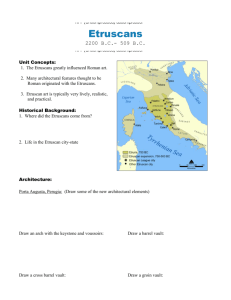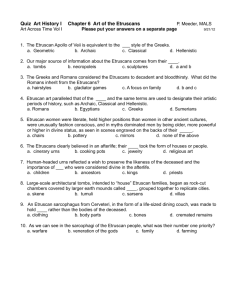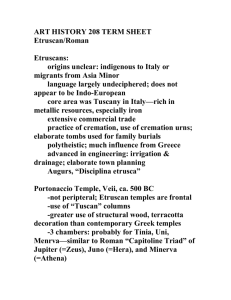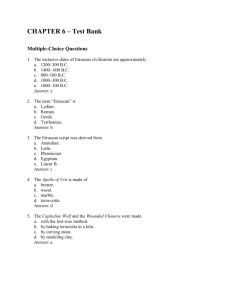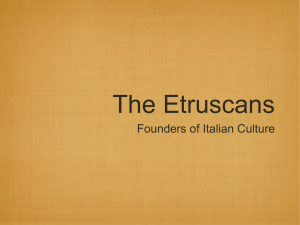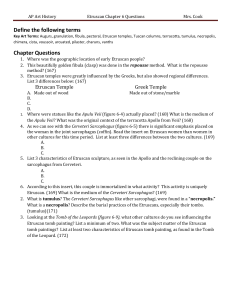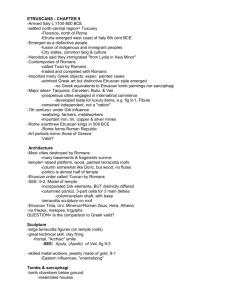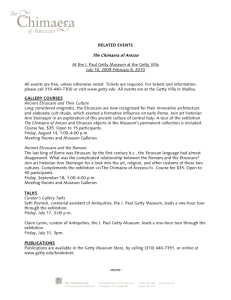A Brief History of Etruscan Civilization
advertisement
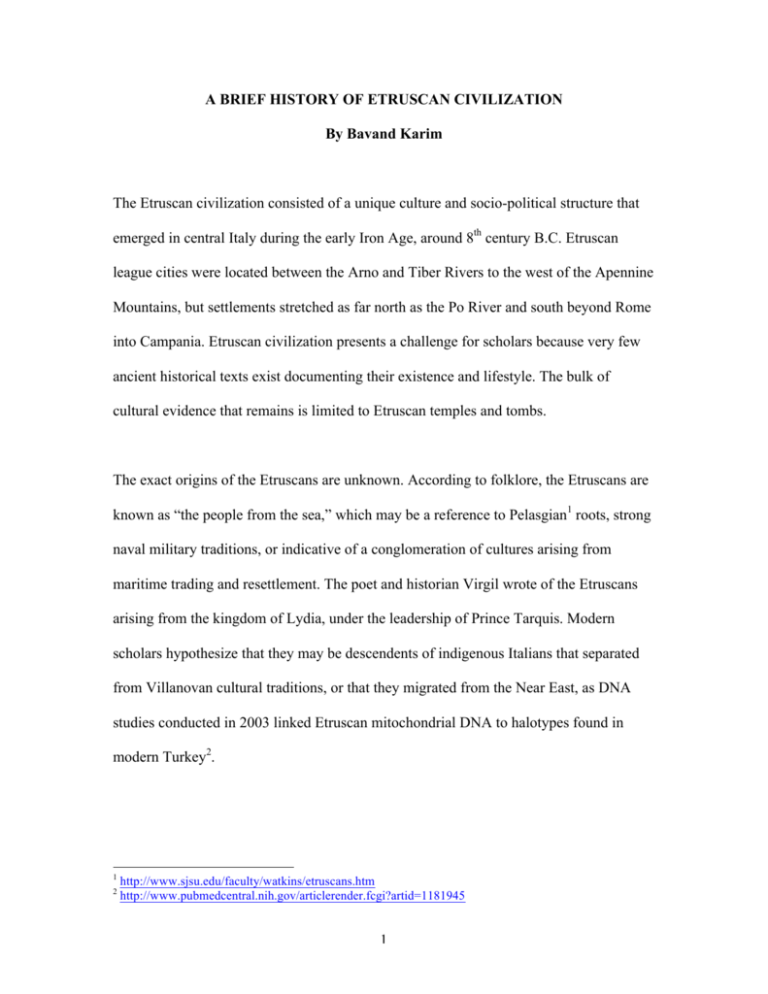
A BRIEF HISTORY OF ETRUSCAN CIVILIZATION By Bavand Karim The Etruscan civilization consisted of a unique culture and socio-political structure that emerged in central Italy during the early Iron Age, around 8th century B.C. Etruscan league cities were located between the Arno and Tiber Rivers to the west of the Apennine Mountains, but settlements stretched as far north as the Po River and south beyond Rome into Campania. Etruscan civilization presents a challenge for scholars because very few ancient historical texts exist documenting their existence and lifestyle. The bulk of cultural evidence that remains is limited to Etruscan temples and tombs. The exact origins of the Etruscans are unknown. According to folklore, the Etruscans are known as “the people from the sea,” which may be a reference to Pelasgian1 roots, strong naval military traditions, or indicative of a conglomeration of cultures arising from maritime trading and resettlement. The poet and historian Virgil wrote of the Etruscans arising from the kingdom of Lydia, under the leadership of Prince Tarquis. Modern scholars hypothesize that they may be descendents of indigenous Italians that separated from Villanovan cultural traditions, or that they migrated from the Near East, as DNA studies conducted in 2003 linked Etruscan mitochondrial DNA to halotypes found in modern Turkey2. 1 2 http://www.sjsu.edu/faculty/watkins/etruscans.htm http://www.pubmedcentral.nih.gov/articlerender.fcgi?artid=1181945 1 The Etruscans are generally accepted to be the first major civilization to emerge in Italy; large enough to create a system of city-states with a transportation infrastructure, implement mining and agriculture, and produce detailed and valuable artwork. Because the Etruscan civilization existed prior to the establishment of the Roman Empire, it had a profound influence in the development of ancient Rome, and in fact Etruscan kings ruled the village of Ruma for at least five decades. However, Etruscan social customs were distinctly different from the cultures of surrounding civilizations, especially in regard to their art, language, and to the liberties afforded to Etruscan women, some of whom enjoyed positions of elevated social and political status. Etruscan culture had a sort of mystic and ephemeral quality, with an emphasis on the temporary nature of life and permanence of death. Religious ceremonies and funeral rights were of the utmost importance as many aspects of Etruscan culture and art were motivated by a strong belief in the afterlife. Polytheistic Etruscan priests practiced divination, interpreting animal entrails or natural phenomenon as omens from the gods3. Etruscan funerary practices were focused on the long-term: the dead were cremated, the ashes placed in delicately crafted urns, and buried in elaborate tombs. The Etruscans had a firm belief in the supernatural and emphasized the relationship between the individual and the gods. Their most treasured cultural relics are detailed artworks that serve to illustrate Etruscan mythology. Temples were often the center of Etruscan settlements, constructed as open-air meeting places where citizens left public offerings to win the gods’ favor. Remnants of Etruscan writing are almost exclusively concerned with religion, and so it is speculated among scholars that Etruscan city-states, which were 3 De Grummond, Simon, 136. 2 often distinctly ethnically stratified and geographically divided, were most strongly united by their religious beliefs4. Etruscan art was figurative in nature, consisting of carved bucchero pottery, terracotta, and clay sculpture, as well as cast bronze, wall paintings or frescoes, and metalwork including engraved bronze mirrors. Much of the artwork and many of the urns found in Etruscan tombs feature images of empowered women or couples embracing, which leads scholars to believe that family was central to Etruscan society where women held social respect. A number of Etruscan tombs carry funerary inscriptions in the form of “X son of (father) and (mother),” indicating the importance of the mother’s side of the family. Etruscan women sat next to their husbands at banquets and owned property. This is in stark contrast to the cultures of Greece and Republican Rome, where respectable women were confined to the house and mixed-sex socializing did not occur5. However, it is worth noting that within funerary tombs were almost exclusively interred wealthy aristocratic families, as signified by the opulence of the figures represented on the sarcophagi, thus the full scope of Etruscan social customs cannot be derived from funerary tombs alone. The language of the Etruscans is a defining characteristic of their culture, as it is distinctly unique when compared to the Indo-European languages of contemporary Italic and Celtic peoples6. The ambiguity of Etruscan language is exacerbated by the fact that it bears resemblance to both the northern Rhaetic language and the western Lemnian 4 http://en.wikipedia.org/wiki/Etruscan_history http://en.wikipedia.org/wiki/Etruscan_civilization 6 http://en.wikipedia.org/wiki/Etruscan_origins#cite_note-lydia-0 5 3 language7, which brings into question the exact chronology of the expansion of Etruscan influence into these surrounding areas. It is important to note that no major literary works in Etruscan have survived. However, there is evidence for the existence of religious and historical literature and drama8. The majority of Etruscan language samples that have been found are funerary inscriptions made on tombs, which include the names of gods, kings, or important citizens. More often than not, this information exists in a sort of vacuum, and therefore provides little historical context or insight into Etruscan culture. Numerous non-Etruscan artifacts found around Etruscan settlements attest to the their vast trade network in the Mediterranean. Etruscan territory included the richest mining areas of Italy and their economy is believed to have been primarily reliant upon the trading of metal goods and utensils, bronze jewelry, and household items. Etruscan gold and iron work was among the finest anywhere in the ancient world, and the Etruscans were among the first artisans to create jewelry made of gold or bronze metals mixed with precious stones and gems. The fertile soils of the Italian valleys supported the agriculture of barley, millet, wheat, olives, grapes, and other fruits and vegetables, and Etruscan farmers raised a variety of animals for consumption as well. Some of the texts of Pliny document quite specifically the wine-production in Etruria, specifically at the ancient port of Gravisca and in Statonia, where vineyards were sufficient to assure a relevant foreign trade of Etruscan wine9. 7 Bonfante, 56. Bonfante, 58. 9 http://penelope.uchicago.edu/~grout/encyclopaedia_romana/wine/wine.html and http://www.vinilazio.com/History of wine/ 8 4 Trade in the region demanded seafaring vessels, and similar to the contemporary cultures of ancient Greece and Rome, the Etruscans had a significant military tradition, with wealthy Etruscans holding ranks of position within the military. The result was a powerful naval force, which the Etruscans used to raid neighboring areas, thereby increasing their territory. Etruscan military weaponry was greatly enhanced by their mining industry, which produced copper, lead, iron, and tin. The commerce of Etruscan metalwork and art led to the expansion of Etruscan influence across the Italian peninsula and the western Mediterranean Sea. It may have been such territorial conflicts that caused Etruscan interests to collide with those of the Greeks. In the sixth century B.C., the Phoceans of Italy founded colonies along the coast of France, Catalonia, and Corsica10. This led the Etruscans to form an alliance with the Carthaginians, who interests also contradicted those of the Greeks. The Etruscans prophesized their own downfall, and indeed, by the first century B.C., the majority of Etruscan territories had been absorbed the growing Roman Empire. Etruscan city-states, although well-fortified behind walls and with high towers, were not strongly affiliated or allied—a disconnect which ultimately led to their collapse. It is speculated that the abundance of multi-cultural influences in Etruria led to an increasing lack of cultural distinction, which facilitated the adoption of the Etruscan upper class by the Romans. The best of Etruscan culture, presumably, is represented by the artifacts found at Poggio Colla and other Etruscan settlements, many of which have only been recently discovered 10 http://www.mysteriousetruscans.com/ 5 and excavated. Bronze and gold relics notwithstanding, the real value of discovering these objects is to provide some historical, social, and cultural insight and context regarding Etruscan culture. However, the unfortunate cost of the process of archeological discovery is the destruction of much of the context in which many of these items existed and were preserved. The origins and exact nature of Etruscan civilization may never be discovered, and for archeologists, the challenge remains to provide some sense of meaning behind ancient objects and rituals, many of which have not been seen or used for thousands of years. 6 Bibliography Books Bonfante, Giuliano, and Bonfante, Larissa. “The Etruscan Language: An Introduction.” Second Edition. Manchester University Press, 2002. De Grummond, Nancy Thomson, and Simon, Erica. “The Religion of the Etruscans.” University of Texas Press, 2006. Lawrence, D.H. “Etruscan Places.” Penguin, 2008. Warden, Gregory. “From the Temple and the Tomb: Etruscan Treasures from Tuscany.” SMU Meadows Museum, 2008. Websites “Etruscan Civilization,” Wikipedia, http://en.wikipedia.org/wiki/Etruscan_civilization “Etruscan History,” Wikipedia, http://en.wikipedia.org/wiki/Etruscan_history “Etruscan Origins,” Wikipedia, http://en.wikipedia.org/wiki/Etruscan_origins#cite_note-lydia-0 “History of Wine,” Vini Lazio: Wine Food and Culture, http://www.vinilazio.com/History of wine/ “The Etruscans: A Population-Genetic Study, The American Journal of Human Genetics, http://www.pubmedcentral.nih.gov/articlerender.fcgi?artid=1181945 “The Mysterious Etruscans,” Reflections on the Etruscan Civilization, http://www.mysteriousetruscans.com/ “The Origins of the Etruscans,” San Jose State University, http://www.sjsu.edu/faculty/watkins/etruscans.htm “Wine and Rome,” University of Chicago, http://penelope.uchicago.edu/~grout/encyclopaedia_romana/wine/wine.html 7
